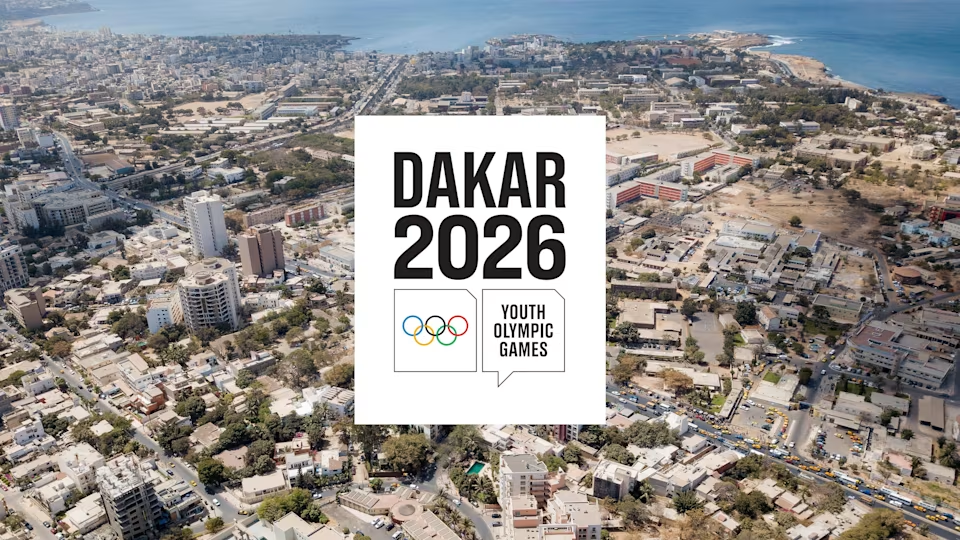When the Youth Olympic Games (YOG) arrive in Senegal, Dakar 2026 from 31 October to 13 November 2026, it will mark a historic milestone: the first Olympic event ever hosted on African soil.
But Dakar 2026 is not simply about symbolism or continental firsts. It represents a strategic rethinking of what the Youth Olympic Games are meant to achieve, and how they can better support local development, cultural identity, gender equality, and long-term participation in sport. The IOC has taken a tailored approach for Dakar, designing a sports programme that emphasizes sustainability, accessibility, and cultural relevance moving away from the model of simply downscaling the main Olympic Games. The program is structured to ensure maximum use of existing venues, minimize new construction, and deliver meaningful, lasting benefits beyond the two-week event.
A Youth Olympic Games Built for Africa
The Games will be spread across three hubs Dakar, Diamniadio, and Saly integrating urban, government, and coastal environments to reflect Senegal’s cultural and geographic diversity. Central to the vision is Teranga, the Senegalese tradition of warmth and hospitality, which the organizing committee sees as the emotional foundation of the event.

Beyond celebration, Dakar 2026 is intended as a catalyst for youth policies, new sporting pathways, and local leadership development. The organizers are prioritizing African agency, ensuring that the Games are not an imported festival but a platform for African youth to shape, perform, and lead.
A New Sports Program Model
Dakar 2026 will feature 35 sports, divided into two categories:
| Category | Number of Sports | Purpose |
| Competition Sports | 25 | Medals awarded; elite performance focus |
| Engagement Sports | 10 | Non-medal; youth participation & cultural connection |
This dual-track system is a structural innovation. It allows the Games to remain selective and competitive, while simultaneously opening space for broader youth engagement and local community involvement.
Setting a Global Standard for Gender Equality
Dakar 2026 will be the first Olympic event to achieve full gender equality at every level.
- 1,350 girls and 1,350 boys, totaling ~2,700 athletes
- Equal number of medal events for men and women
- Mixed-gender events included to promote team integration
Equality isn’t just symbolic. International Federations were required to restructure their event formats to create equal competitive spaces making Dakar 2026 a global benchmark in youth sport governance. Additionally, women hold three of the seven major leadership roles on the Dakar organizing committee ensuring that gender balance is reflected behind the scenes, not only on the field.
New Sports Designed for Youth Culture and Local Identity
Four sports debut at Dakar 2026 each selected for youth appeal, accessibility, and cultural connection.
Baseball5 (Competition Sport)
A fast, urban, equipment-free team sport that can be played anywhere. No bats, no gloves—just movement, awareness, and creativity.
Skateboarding (Street) (Competition Sport)
With skate culture growing in African cities, particularly as a vehicle for youth expression, Skateboarding’s inclusion is both symbolic and strategic.
Wushu (Competition Sport)
Wushu’s popularity across Africa owes much to the cultural influence of martial arts films. The event will focus on Taolu routines and will feature gender-balanced combined formats. The sport’s international federation is developing an AI-assisted judging system to ensure fairness.
Surfing (Engagement Sport)
Surfing will not award medals—by design. Senegal’s 700 km Atlantic coastline, rich surf history, and youth ocean culture make it the perfect participation and festival sport.
Reimagining Existing Sports for the African Context
Several disciplines have been strategically adapted to fit local heritage, venue availability, and youth appeal:
- Beach Wrestling replaces Greco-Roman, aligning with Senegal’s iconic Lutte wrestling culture.
- Cycling shifts to individual events, reducing logistical load and improving athlete safety.
- Sport Climbing becomes Bouldering-only, simplifying venue operations.
- Trampoline Gymnastics is removed, allowing Artistic Gymnastics to remain within limits on discipline count.
These decisions are not cost-cutting measures—they are program integrity measures, prioritizing relevance and sustainability.
Dakar 2026 Will Leave a Legacy Beyond Competition
The Games are expected to:
- Strengthen youth sports structures
- Expand women’s leadership pathways
- Improve coastal and urban sports infrastructure
- Inspire future African hosts across major sporting events
Dakar 2026 is designed to shift the center of gravity of global youth sport, placing Africa not at the periphery, but at the front of the Olympic future.
The Youth Olympic Games in Dakar are more than an event—they are a model. A model for how sport can be localized, how global structures can adapt, and how a continent can assert its cultural and athletic identity on the world stage.
Dakar 2026 is not asking Africa to fit the Olympics. It is reshaping the Olympics to fit Africa.
How useful was this post?
Click on a star to rate it!
Average rating 0 / 5. Vote count: 0
No votes so far! Be the first to rate this post.





